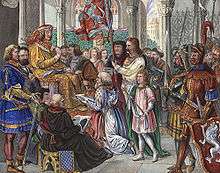Albert III, Duke of Bavaria
Albert III the Pious of Bavaria-Munich (German: Albrecht III. der Fromme, Herzog von Bayern-München; 27 March 1401 – 29 February 1460), since 1438 Duke of Bavaria-Munich. He was born in Wolfratshausen to Ernest, Duke of Bavaria and Elisabetta Visconti, daughter of Bernabò Visconti.
Albert III the Pious of Bavaria-Munich | |
|---|---|
 Albert III rejects the Bohemian crown; Painting by J.G.Hiltensberger, Hofgarten in Munich | |
| Born | 27 March 1401 Wolfratshausen |
| Died | 29 February 1460 (aged 58) Munich |
| Buried | Andechs |
| Noble family | House of Wittelsbach |
| Spouse(s) | Agnes Bernauer Anna of Brunswick-Grubenhagen-Einbeck |
| Father | Ernest, Duke of Bavaria |
| Mother | Elisabetta Visconti |
Life
Albert was first engaged in 1429 to Elisabeth, the daughter of Eberhard III, Count of Württemberg, but she eloped and married Count John IV of Werdenberg, who had been a page at her father's court.
In 1432, while Albert was administrator on behalf of his father Ernest, Duke of Bavaria-Munich in the former duchy of Bavaria-Straubing, he secretly married Agnes Bernauer, a maid from Augsburg. His father was against this marriage. In 1435, when Agnes lived in Straubing, Duke Ernest ordered her to be murdered. She was accused of witchcraft, thrown into the Danube River and drowned while Albert was away hunting. After his first wife's death, Albert remained with Louis VII, Duke of Bavaria-Ingolstadt at Ingolstadt, but he reconciled with his father that November.
After reconciliation with his father, Albert married princess Anna of Brunswick-Grubenhagen-Einbeck as his second wife and had ten children with her.
In 1438, Albert succeeded his father as duke of Bavaria-Munich. Around 1438-39, he built Blutenburg Castle between two arms of the River Würm into a hunting lodge. The castle was later extended by his third son Sigismund. In 1440, Albert refused the offered Bohemian crown. In 1442, he expelled the Jews from all Upper Bavarian territories. It was not until 250 years later that Jewish settlement was allowed again. In 1444 and 1445, he initiated two campaigns against the Robber barons. After the extinction of the dukes of Bavaria-Ingolstadt, Albert released this duchy to his father's cousin Henry XVI of Bavaria-Landshut in 1447.
In 1455, Albert founded the Benedictine monastery in Andechs. He died in Munich in 1460 and was buried in Andechs.
Ancestors
| Ancestors of Albert III, Duke of Bavaria | ||||||||||||||||||||||||||||||||||||||||||||||||||||||||||||||||||||||||||||||||||||||||||||||||||||||||||||||||||||||||||||||||||||||||||||||||||||||||||||||||||||||||||||||||||||||||||||||||||||||||||||||||||||||||||||||||||||||||||||||||||||||||||||||||||||||||||||||||||||||||||||||||||||||||||||||||||||||||||||||||||||||||||||||||||||||||||||||||||||||||||||||||||||||||||||||||||||||||||||||||||||||||||||||||||||||||||||||||||||||||||||||||||||||||||||||||||||||||||||||||||||||||||||||||||||||||||||||||||||||||||||||||||||||||||||||||||||||||||||||||||||||||||||||||||||||||||||||||
|---|---|---|---|---|---|---|---|---|---|---|---|---|---|---|---|---|---|---|---|---|---|---|---|---|---|---|---|---|---|---|---|---|---|---|---|---|---|---|---|---|---|---|---|---|---|---|---|---|---|---|---|---|---|---|---|---|---|---|---|---|---|---|---|---|---|---|---|---|---|---|---|---|---|---|---|---|---|---|---|---|---|---|---|---|---|---|---|---|---|---|---|---|---|---|---|---|---|---|---|---|---|---|---|---|---|---|---|---|---|---|---|---|---|---|---|---|---|---|---|---|---|---|---|---|---|---|---|---|---|---|---|---|---|---|---|---|---|---|---|---|---|---|---|---|---|---|---|---|---|---|---|---|---|---|---|---|---|---|---|---|---|---|---|---|---|---|---|---|---|---|---|---|---|---|---|---|---|---|---|---|---|---|---|---|---|---|---|---|---|---|---|---|---|---|---|---|---|---|---|---|---|---|---|---|---|---|---|---|---|---|---|---|---|---|---|---|---|---|---|---|---|---|---|---|---|---|---|---|---|---|---|---|---|---|---|---|---|---|---|---|---|---|---|---|---|---|---|---|---|---|---|---|---|---|---|---|---|---|---|---|---|---|---|---|---|---|---|---|---|---|---|---|---|---|---|---|---|---|---|---|---|---|---|---|---|---|---|---|---|---|---|---|---|---|---|---|---|---|---|---|---|---|---|---|---|---|---|---|---|---|---|---|---|---|---|---|---|---|---|---|---|---|---|---|---|---|---|---|---|---|---|---|---|---|---|---|---|---|---|---|---|---|---|---|---|---|---|---|---|---|---|---|---|---|---|---|---|---|---|---|---|---|---|---|---|---|---|---|---|---|---|---|---|---|---|---|---|---|---|---|---|---|---|---|---|---|---|---|---|---|---|---|---|---|---|---|---|---|---|---|---|---|---|---|---|---|---|---|---|---|---|---|---|---|---|---|---|---|---|---|---|---|---|---|---|---|---|---|---|---|---|---|---|---|---|---|---|---|---|---|---|---|---|---|---|---|---|---|---|---|---|---|---|---|---|---|---|---|---|---|---|---|---|---|---|---|---|---|---|---|---|---|---|---|---|---|---|---|---|---|---|---|---|---|---|---|---|---|---|---|---|---|---|---|---|---|---|---|---|---|---|---|---|---|---|---|---|---|---|---|---|---|---|---|---|---|---|---|---|---|---|---|---|---|---|---|---|---|---|---|---|---|---|---|---|---|---|---|---|---|---|---|---|---|---|---|---|---|---|---|---|---|---|---|---|---|---|---|---|---|---|---|---|---|---|---|---|---|---|---|---|---|---|---|---|---|---|---|---|---|---|---|---|---|---|---|---|---|---|---|---|---|
| ||||||||||||||||||||||||||||||||||||||||||||||||||||||||||||||||||||||||||||||||||||||||||||||||||||||||||||||||||||||||||||||||||||||||||||||||||||||||||||||||||||||||||||||||||||||||||||||||||||||||||||||||||||||||||||||||||||||||||||||||||||||||||||||||||||||||||||||||||||||||||||||||||||||||||||||||||||||||||||||||||||||||||||||||||||||||||||||||||||||||||||||||||||||||||||||||||||||||||||||||||||||||||||||||||||||||||||||||||||||||||||||||||||||||||||||||||||||||||||||||||||||||||||||||||||||||||||||||||||||||||||||||||||||||||||||||||||||||||||||||||||||||||||||||||||||||||||||||
Family and children
On 22 January 1437, in Munich, he married Anna of Brunswick-Grubenhagen-Einbeck, daughter of Duke Eric I of Brunswick-Grubenhagen and Elisabeth of Brunswick-Göttingen and they had the following children:
- John IV, Duke of Bavaria (4 October 1437, Munich–18 November 1463, Haidhausen).
- Ernest (26 August 1438, Munich–29 February 1460, Straubing).
- Sigismund of Bavaria (1439, Straubing–1 February 1501, Blutenburg Castle).
- Albert (24 December 1440–1445, Straubing).
- Margaret (1 January 1442, Munich–14 October 1479, Mantua), married in Mantua 10 May 1463 to Federico I Gonzaga.
- Elisabeth (2 February 1443–5 March 1486, Leipzig), married in Leipzig 19 November 1460 to Elector Ernst of Saxony.
- Albert IV, Duke of Bavaria (15 December 1447, Munich–10 March 1508, Munich).
- Christoph, Duke of Bavaria (6 January 1449–8 August 1493, Rhodes).
- Wolfgang (1 November 1451–24 May 1514, Landsberg am Lech), a canon in Passau, Augsburg and Köln.
- Barbara (9 June 1454, Munich–24 June 1472, Munich), a nun in Munich.
Also he had at least three illegitimate children.
Albert III, Duke of Bavaria Born: 27 March 1401 Died: 29 February 1460 | ||
| Regnal titles | ||
|---|---|---|
| Preceded by Ernest |
Duke of Bavaria-Munich 1438–1460 |
Succeeded by John IV |